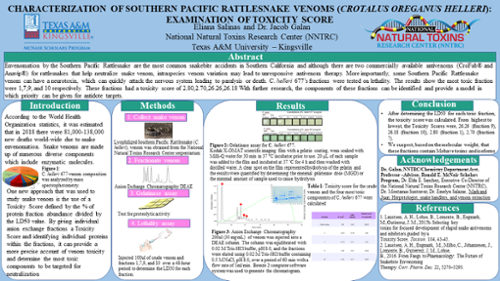Envenomation by the Southern Pacific Rattlesnake (Crotalus Oreganus Helleri) are the most common snakebite accidents in Southern California and although there are two commercially available antivenoms (CroFab® and Anavip®) for rattlesnakes that help neutralize snake venom, intraspecies venom variation may lead to unresponsive antivenom therapy. More importantly, some Southern Pacific Rattlesnake venom can have neurotoxins, which can quickly attack the nervous system leading to paralysis or death. Herein, this study examines and explores the specific toxins in the Southern Pacific Rattlesnake that have the most toxicity when snake envenomation occurs. C helleri 677’s fractions were tested for gelatinase activity and lethality. The results showed that in the gelatinase assay, there were no signs of enzymatic activity and in the lethality assay (LD50) the most toxic fractions were 1,7,9, and 10 respectively. After a 48-hour period in the lethality assay, the toxicity scores were determined. From highest to lowest, the toxicity scores were: 26.26 (fraction 9), 26.18 (fraction 10), 2.80 (fraction 1), and 2.70 (fraction 7). This will provide a model in which priority can be given for antidote targets. Furthermore, this method can be used for other snakebites in order to study synergistic effects and to create a more precise and effective antidote.
Faculty mentor: Dr. Jacob Galan
Natural Toxins Research Center


